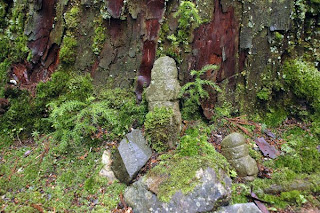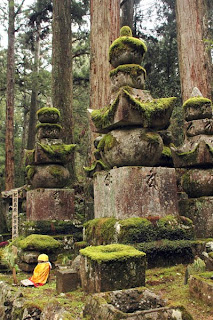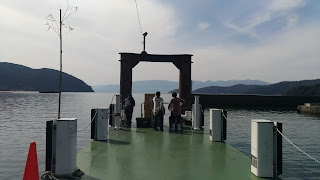One day trip to Koya-san
Recently I went for the second time to Mounts Koya (Koya-san in japanese) as a one day trip...
The first time was 4 years ago during the Golden Week. Everything was so crowded there ... It didn't really looked like a quiet journey in a peaceful place. However I kept good memories of the hiking we made in the surrounding mountains to escape the crowd, and of the impressive graveyard.
This year we could experience a completely different Koya-san. Middle of April, middle of the week, bad weather, ... There was no-bo-dy, and the few monks and tourists walking through the fog looked more like ghosts escaped from the stones of this mystic forest.
Having avoided most of the town and seen only half of the graveyard on the first time, we decided to start with the graveyard and walk up to Oku-no-in. Here rest in peace the souls of numerous Japanese, and amongst them many very famous ones such as Takedo Shingen, Ishida Mitsunari, Oda Nobunaga ... Due to the fame of the bodies lying here, most of the gravestones are splendids and enormous. And there are so many ! It's simply the biggest graveyard in all Japan.
A paved walkway goes through this forest of stones and trees up to the Oku-no-in, the mausoleum of Kukai (also called Koubou Daishi). He was impressed by the configuration of the mountains of the Koya area : it looked like the eight petals of a lotus flower, and reminded him a sacred mountain in China where he went to study. Then he ordered to consecrate this place as the main retreat for Shingon Buddhism. Later Toyotomi Hideyoshi constructed the head quarter of this sect : the Kongoubuji temple.
Oku-no-in is surrounded by an area where pictures can't be taken. It starts from a bridge over a small river. When we walked through, there was votive plaques hammered in the stream. Some pilgrims were heading to the mausoleum to receive their 'noukyou' (calligraphy delivered in each temples of a pilgrimage). Oku-no-in is quite simple when seen from the outside, it doesn't impressed with some fancy architecture. But from the inside, the hugeness of the hall, and the wealth in furniture command respect.
Three Japanese were receiving a service from a monk singing in front of a calligraphy of 'Koubou'. Two other monks were writing the kanjis of the four seasons on small papers. We could pray after washing our hands with ashes, an alternative way to the more common water running from a fountain at the entrance of the temple. I loved the smell of my hand when I prayed and kept attention few seconds on my breath...
After passing back the small river we had a little rest in a building prepared for pilgrims and visitors. A huge cauldron keeps some hot tea, tables and benches surround an altar, a large tv screen displays a promotional video on Koya-san.
And then we came back to the entrance of the graveyard. Until we caught the bus toward the 'downtown' we could eat some delicious mochi and sweets in the cafe in front of the bus stop. The city is so small we could easily go by foot but we had a bus pass, it's always funny to take the bus when you are alone inside, and it made us save some time.
We went then to visit the Kongoubuji. It is the must-see as it is the main temple of the city. The building as some interesting architectural particularities and a wide mineral garden. You can also have tea in a large room where a monk gives a lecture. The first time we went there, it was about the meaning of the sentence we use at beginning of each meal : "itadakimasu". The second time there was no lecture.
After some shopping of souvenirs (including delicious sesame flavored tofu), we went to the Joufukuin. This one has a very special underground walkway into pitch blackness. Walk through without fear to prove your faith !
And finally it was time to come back home. During all the day we used the Nankai Koya Pass. It gives you access to Mounts Koya (train and ropeway) from Namba station in Osaka, and covers the bus lines in Koya, as well as offers many reductions in souvenir shops, temples, and museums, for 3310 yen. It takes 1h30mn to go from Namba to Koya.
The first time was 4 years ago during the Golden Week. Everything was so crowded there ... It didn't really looked like a quiet journey in a peaceful place. However I kept good memories of the hiking we made in the surrounding mountains to escape the crowd, and of the impressive graveyard.
This year we could experience a completely different Koya-san. Middle of April, middle of the week, bad weather, ... There was no-bo-dy, and the few monks and tourists walking through the fog looked more like ghosts escaped from the stones of this mystic forest.
Having avoided most of the town and seen only half of the graveyard on the first time, we decided to start with the graveyard and walk up to Oku-no-in. Here rest in peace the souls of numerous Japanese, and amongst them many very famous ones such as Takedo Shingen, Ishida Mitsunari, Oda Nobunaga ... Due to the fame of the bodies lying here, most of the gravestones are splendids and enormous. And there are so many ! It's simply the biggest graveyard in all Japan.
A paved walkway goes through this forest of stones and trees up to the Oku-no-in, the mausoleum of Kukai (also called Koubou Daishi). He was impressed by the configuration of the mountains of the Koya area : it looked like the eight petals of a lotus flower, and reminded him a sacred mountain in China where he went to study. Then he ordered to consecrate this place as the main retreat for Shingon Buddhism. Later Toyotomi Hideyoshi constructed the head quarter of this sect : the Kongoubuji temple.
Oku-no-in is surrounded by an area where pictures can't be taken. It starts from a bridge over a small river. When we walked through, there was votive plaques hammered in the stream. Some pilgrims were heading to the mausoleum to receive their 'noukyou' (calligraphy delivered in each temples of a pilgrimage). Oku-no-in is quite simple when seen from the outside, it doesn't impressed with some fancy architecture. But from the inside, the hugeness of the hall, and the wealth in furniture command respect.
Three Japanese were receiving a service from a monk singing in front of a calligraphy of 'Koubou'. Two other monks were writing the kanjis of the four seasons on small papers. We could pray after washing our hands with ashes, an alternative way to the more common water running from a fountain at the entrance of the temple. I loved the smell of my hand when I prayed and kept attention few seconds on my breath...
After passing back the small river we had a little rest in a building prepared for pilgrims and visitors. A huge cauldron keeps some hot tea, tables and benches surround an altar, a large tv screen displays a promotional video on Koya-san.
And then we came back to the entrance of the graveyard. Until we caught the bus toward the 'downtown' we could eat some delicious mochi and sweets in the cafe in front of the bus stop. The city is so small we could easily go by foot but we had a bus pass, it's always funny to take the bus when you are alone inside, and it made us save some time.
We went then to visit the Kongoubuji. It is the must-see as it is the main temple of the city. The building as some interesting architectural particularities and a wide mineral garden. You can also have tea in a large room where a monk gives a lecture. The first time we went there, it was about the meaning of the sentence we use at beginning of each meal : "itadakimasu". The second time there was no lecture.
After some shopping of souvenirs (including delicious sesame flavored tofu), we went to the Joufukuin. This one has a very special underground walkway into pitch blackness. Walk through without fear to prove your faith !
And finally it was time to come back home. During all the day we used the Nankai Koya Pass. It gives you access to Mounts Koya (train and ropeway) from Namba station in Osaka, and covers the bus lines in Koya, as well as offers many reductions in souvenir shops, temples, and museums, for 3310 yen. It takes 1h30mn to go from Namba to Koya.












Comments